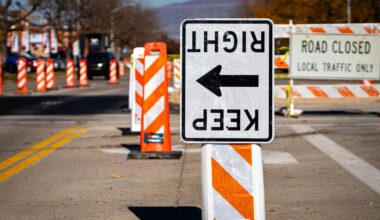Workers step onto construction sites across Canada daily, each a hive of activity, with towering cranes, powerful machinery, and intricate designs taking shape. However, amidst the hustle and bustle of construction work, one element is crucial to ensuring safety: the construction signs in Canada. These signs, simple as they may seem, serve as lifelines, preventing injuries and accidents and potentially saving lives.
This article will explore the 11 essential construction signs you should know as a worker, visitor, or contractor in Canada. Understanding these signs and their significance can differentiate between a productive, injury-free day and a tragic accident. So, let’s dive in and highlight the crucial signs that every worker on Canadian construction sites should be aware of.
1. Hard Hat Area
What it Means:
This sign indicates that the area is hazardous and that wearing a hard hat is required. It is commonly placed in zones with overhead hazards like falling objects or tools.
Advertisements
Why It’s Important:
The hard hat is the most basic yet crucial safety equipment on any construction site. Falling debris, tools, or materials can cause serious head injuries or fatalities. By wearing a hard hat, workers protect themselves from these potential dangers. This sign is a reminder to stay safe and prevent head injuries in high-risk areas.
Illustration: A yellow sign with a hard hat symbol and the words “Hard Hat Area” clearly displayed.
2. High Voltage Warning
What it Means:
This sign alerts workers to the presence of high-voltage electrical systems, which, if mishandled, can cause fatal electrocution.
Advertisements
Why It’s Important:
Electrical hazards are one of the leading causes of workplace fatalities in the construction industry. High-voltage systems can be found in machinery, power lines, or electrical panels. Workers must be trained to handle or avoid these areas, as accidental contact with electricity can lead to severe injuries or death. This sign ensures that everyone on-site knows the risk and remains cautious.
Illustration: A black-and-yellow striped sign with a lightning bolt symbol, signaling high voltage.
3. Flammable Materials
What it Means:
This sign marks areas where flammable materials like fuels, solvents, or chemicals are stored or handled.
Why It’s Important:
Construction sites often involve materials that ignite easily, and an explosion or fire can cause devastating injuries or property damage. This sign is crucial in preventing smoking, sparks, or other ignition sources from entering dangerous zones. It reminds workers to follow safety procedures and be vigilant around hazardous materials.
Illustration: A red-and-white sign with a flame icon indicating the presence of flammable materials.
4. Authorized Personnel Only
What it Means:
This sign restricts access to specific areas, allowing only authorized or trained personnel to enter due to dangerous conditions or equipment.
Why It’s Important:
Certain areas on a construction site may be hazardous due to the operation of heavy machinery, chemicals, or other risk factors. Allowing only trained personnel access to these zones ensures that those who enter are equipped with the proper safety gear and knowledge to protect themselves. Ignoring this sign can result in injury or worse.
Illustration: A red sign with “Authorized Personnel Only” written in bold letters.
5. Eye Protection Required
What it Means:
This sign indicates that workers must wear eye protection in the area to shield against flying debris, chemicals, or bright lights.
Why It’s Important:
Eye injuries are common in the construction industry. The risk of objects like dust, metal shards, or chemicals damaging the eyes is ever-present. Workers are urged to wear goggles or face shields where this risk exists. Ignoring this sign can lead to permanent eye damage or vision loss.
Illustration: A sign with safety goggles and the words “Eye Protection Required.”
6. Slippery Surface – Caution
What it Means:
This sign is used when wet or greasy surfaces pose a slipping hazard. It’s often found in areas after cleaning, near water sources, or where chemicals have been spilled.
Why It’s Important:
Slips, trips, and falls are among the most frequent causes of injury on construction sites. Wet surfaces, ice, or oily patches can make walking dangerous. This sign warns workers to tread carefully and take precautions, such as wearing slip-resistant footwear, to avoid falls.
Illustration: A yellow sign symbolizing a person slipping and the words “Slippery Surface – Caution.
7. Fall Hazard – Use Fall Protection
What it Means:
This sign warns of potential fall hazards, especially in areas where workers may be exposed to heights, like scaffolding, rooftops, or near open holes.
Why It’s Important:
Falls are one of the leading causes of injury and death in the construction industry. This sign emphasizes the need for fall protection systems, such as harnesses, guardrails, or safety nets, when working at heights. Neglecting to follow these safety measures can result in serious, even fatal, injuries.
Illustration: A triangle-shaped sign with an exclamation mark featuring a person falling, with the text “Fall Hazard – Use Fall Protection.”
8. No Smoking
What it Means:
This sign indicates areas where smoking is prohibited, usually due to the presence of flammable materials or chemicals.
Why It’s Important:
Smoking in areas with flammable or combustible materials can lead to explosions, fires, or toxic fumes. This simple yet vital sign reminds workers to refrain from smoking in hazardous zones, helping to prevent fire hazards and maintain safety.
Illustration: A red circle with a cigarette and a line through it, signaling no smoking.
9. Gas Leak – Evacuate Area
What it Means:
This sign warns workers of a gas leak, which can pose serious risks of explosions, fire, or poisoning.
Why It’s Important:
Gas leaks are among the most dangerous hazards on a construction site. Whether it’s natural gas or another toxic gas, workers must evacuate the area immediately to avoid inhalation or fire risks. The sign ensures that workers stay informed and take swift action to protect themselves and others.
Illustration: A yellow sign with a gas mask symbol and the words “Gas Leak – Evacuate Area.
10. No Entry – Construction Zone
What it Means:
This sign restricts access to certain construction site areas, often where demolition, excavation, or heavy machinery operation occurs.
Why It’s Important:
Certain parts of a construction site may be unsafe for untrained workers or visitors due to the risk of falling debris, machinery movement, or unstable structures. This sign helps prevent accidents by keeping unauthorized individuals out of high-risk areas.
Illustration: A bold red sign with a “No Entry” symbol and the words “Construction Zone.”
11. Crane Swing Area
What it Means:
This sign warns workers of the area where a crane is in operation and indicates the potential swing radius of the crane’s load.
Why It’s Important:
Cranes are common in many construction sites, but their operation poses significant risks to those working nearby. This sign alerts workers to stay out of the crane’s swing radius to avoid being struck by heavy loads. Cranes have blind spots, and the risk of being hit by a swinging load can be fatal.
Illustration: A yellow warning sign with a crane and a swinging load indicating a danger zone.
Construction Signs in Canada (Stay Safe, Stay Smart)
The construction industry is one of the most dangerous fields, with workers constantly exposed to various risks. However, construction signs are among the best tools to mitigate these dangers and keep workers safe. Understanding and following the warnings these signs provide significantly reduces the risk of accidents and injuries.
In Canada, where construction projects are widespread, recognizing the meaning and importance of these 11 key signs is essential for anyone working on or near a construction site. Whether you’re a seasoned professional or a visitor, the safety of the workers around you depends on everyone’s vigilance and adherence to these signs.
Remember: safety is not just a rule; it’s a shared responsibility. So, next time you step onto a construction site, take a moment to observe the safety signs. By doing so, you ensure that both you and your colleagues return home safely every day.
Advertisements






